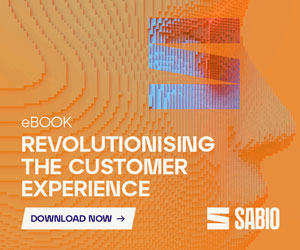Jayadeep Subhashis at Sprinklr provides insights into the top customer experience (CX) trends you must know. By effectively leveraging these trends, you can meet and exceed customer expectations, gaining a crucial competitive advantage.
In 2025, the business landscape is sharply divided between those recognizing the transformative power of customer experience (CX) and those who risk being left behind by failing to prioritize it.
Every choice your customers make, from the smartphone they carry to the car they drive and the streaming service they subscribe to, is governed by the quality of the experience it delivers.
As per CX statistics, enhancing customer experience can result in a decrease in customer churn rate by almost 15%, along with potential increases in win rates of nearly 40%. This underscores CX’s undeniable influence on consumer behaviour and the consequent imperative for you to prioritize it.
As CX continues to gain momentum, it’s essential to understand that the landscape is ever-evolving and characterized by highly dynamic trends.
Staying abreast of the latest developments is crucial for thriving amidst ongoing innovations and ensuring preparedness for the future.
What Is Customer Experience (CX)?
Customer experience (CX) is the total interactions and impressions a customer has with your brand across all touchpoints and channels.
It encompasses every aspect of the customer journey, from initial awareness to post-purchase support, to create positive emotions, satisfaction and loyalty.
In today’s competitive landscape, a robust CX strategy is essential for understanding and meeting customer needs and expectations. Here’s why improving customer experience is a priority today.
Why Is Customer Experience Important for Businesses?
In 2025, you can no longer rely solely on the strength of your products or services, as competitors can easily replicate them. This reality and several other compelling reasons have made customer experience integral to every business’ core strategy.
The Loyalty Lock-In
Studies show that 58% of US customers are willing to pay more for a better customer experience. This underscores the direct correlation between investing in CX, which fosters loyalty, encourages repeat business and reduces customer churn.
Loyal customers become brand advocates, recommending your products and services to others, driving organic growth and market share expansion.
The Tech-Fuelled Shift
With customers becoming increasingly tech-savvy, the demand for seamless, personalized experiences across all customer touchpoints has skyrocketed.
Leveraging technologies such as AI-powered chatbots and augmented reality (AR) product visualization enables businesses to deliver tailored interactions that delight tech-savvy customers.
The Differentiation Dilemma
In a market saturated with similar products and services, CX emerges as the primary differentiator. Brands like Apple and Zappos have mastered the art of forging emotional connections with customers through their customer-centric approach, resulting in unparalleled market leadership and brand advocacy.
The Data-Driven Future
CX is no longer a subjective concept but a quantifiable metric. Advanced analytics and reporting provide invaluable insights into customer sentiment and behaviour, empowering businesses to proactively identify and address pain points for continuous improvement and optimized experiences.
7 Customer Experience Trends to Follow in 2025
Trend 1: Generative AI
From chatbots that can engage in natural conversations to personalized product recommendations and content creation, generative AI in customer service is reshaping the way businesses interact with customers and deliver tailored experiences.
Gartner predicted in 2025 that 80% of customer service and support organizations will be applying generative AI technology in some form to improve agent productivity and customer experience (CX). Here is how generative AI is going to help:
Personalized Interactions
Generative AI enables you to create personalized interactions with customers across various touchpoints, such as chatbots that can understand natural language queries and provide relevant responses in real time.
Dynamic Content Creation
Since generative AI algorithms can analyse vast amounts of data, you can generate dynamic content tailored to individual preferences and behaviours.
This includes personalized product recommendations, targeted marketing messages and customized content that resonates with each customer segment. By delivering relevant and engaging content, you can drive customer engagement and conversion rates.
Efficiency and Scalability
You can automate repetitive tasks and processes with the help of generative AI and deliver personalized experiences at scale.
This improves operational efficiency, reduces manual effort and enables you to focus on strategic initiatives that drive growth.
Trend 2: Voice and Conversational Interfaces
With the surge of smart speakers and voice-enabled devices, people increasingly turn to voice assistants for various tasks, including placing orders, seeking information and accessing customer service.
This hands-free, intuitive approach offers numerous benefits, including improved accessibility for everyone and an opportunity for businesses to differentiate themselves by providing a unique and convenient customer experience.
Voice bots are another emerging technology. Voice bots utilize the fastest and most intuitive form of communication and elevate customer service levels while speeding up customer response times.
Speaking of voice bots, conversational IVR is gaining wider acceptance across industries. By eliminating lengthy pre-recorded menus, conversational IVR gives customers direct control over call direction.
Automated responses are concise, allowing customers to quickly interrupt and request live agent assistance. This approach significantly increases first-contact resolution rates, enhancing overall efficiency.
In addition, you can leverage virtual assistants and conversational AI to enhance customer engagement and streamline operations.
From answering FAQs to providing personalized recommendations, these technologies offer customers a more natural and convenient way to interact with brands.
This trend, now popularly known as conversational customer service, is driving efficiency and enhancing the overall customer experience.
Trend 3: Data Security and Trust
Data security is pivotal in shaping customer experience and fostering trust between businesses and consumers. With the increasing digitization of customer interactions and the scrutiny of customer communications, safeguarding sensitive data has become more critical than ever.
To address this concern, you must adopt secure customer service channels, implement encryption technologies for data transmission and storage and establish stringent access controls to protect sensitive customer information.
By prioritizing data security measures, you can enhance customer trust and loyalty, safeguard your reputation and foster long-term relationships.
Trend 4: Hyper-Personalization
According to Gartner, 71% of B2C and 86% of B2B customers expect companies to be well-informed about their personal information during an interaction.
Imagine your online store suggesting a specific jacket, considering your customer’s preferred style, past purchases and even the local weather forecast! This tailored approach enhances satisfaction and loyalty and makes customers feel like valued VIPs.
Hyper-personalization, driven by real-time and granular consumer insights, fundamentally reshapes the industry by enabling you to customize experiences based on individual preferences and behaviours.
Machine learning algorithms analyse vast amounts of data, including customer interactions at every touchpoint, to accurately predict their needs and preferences.
Trend 5: Predictive Analytics
By leveraging data-driven insights and predictive modelling techniques, you can anticipate customer behaviour, identify potential issues and proactively engage customers to address their needs before they arise. Here are a few examples:
Personalized Recommendations
If you run an e-commerce business, you can use predictive analytics to analyse past purchase behaviour, browsing history and demographic data to predict future product interests and preferences.
Proactively recommending relevant products to customers can increase cross-selling opportunities, drive repeat purchases and enhance customer satisfaction.
Predictive Maintenance
Manufacturing companies can use predictive analytics to monitor equipment performance and predict maintenance needs before equipment failures occur.
By proactively scheduling maintenance activities and addressing issues before they escalate, you can minimize downtime, improve operational efficiency and ensure consistent product quality.
Proactive Customer Support
Telecommunication companies can leverage predictive analytics to identify potential network issues or service disruptions before they impact customers.
By proactively reaching out to affected customers with timely updates and alternative solutions, you can minimize service downtime, reduce customer frustration and build trust and loyalty.
Trend 6: Augmented Reality (AR) and Virtual Reality (VR)
Augmented reality (AR) and virtual reality (VR) technologies transform how customers experience products and services by offering immersive and interactive experiences.
From virtual try-on experiences to immersive brand storytelling, you can leverage AR and VR to enhance brand experiences, drive customer engagement and increase loyalty.
Trend 7: Seamless Omnichannel Experiences
By 2030, it is predicted that the omnichannel customer engagement market will grow to a whopping $17.92 billion in revenue. Hence, investing in AI-powered omnichannel routing is essential to meet these evolving customer expectations.
Today, customers interact with businesses through multiple contact centre channels, from social media platforms to virtual agents.
Picture a scenario where a customer engages with your brand across various touchpoints, from discovering your ad on YouTube to making inquiries on Instagram and finalizing a purchase through your website’s virtual assistant.
However, when they need to leave specific delivery instructions, they expect a seamless transition to a voice call interaction.
By leveraging real-time data from multiple integrated systems, you can ensure that customers don’t have to repeat themselves across channels. This empowers agents to anticipate and address customer needs swiftly and effectively.
Frequently Asked Questions
What Impact Does AI Have on Customer Experience Trends?
AI significantly impacts customer experience trends by enabling personalized interactions, predictive analytics and automation.
It revolutionizes how businesses engage with customers, enhancing efficiency and satisfaction by delivering tailored experiences at scale.
How Does IoT Influence Customer Experience Trends?
IoT plays a transformative role in customer experience trends by creating interconnected experiences and offering real-time data insights.
It enables personalized services based on user behaviour and preferences, optimizing interactions and enhancing customer satisfaction.
What Role Do Customer Touchpoints Play in the Overall Customer Experience Journey?
Customer touchpoints are essential in the overall customer experience journey, shaping perceptions and interactions at every stage.
From initial engagement to post-purchase support, optimizing touchpoints ensures consistency, satisfaction and fosters long-term loyalty.
Author: Sprinklr
Reviewed by: Megan Jones
Published On: 11th Feb 2025 - Last modified: 12th Feb 2025
Read more about - Guest Blogs, Sprinklr



































